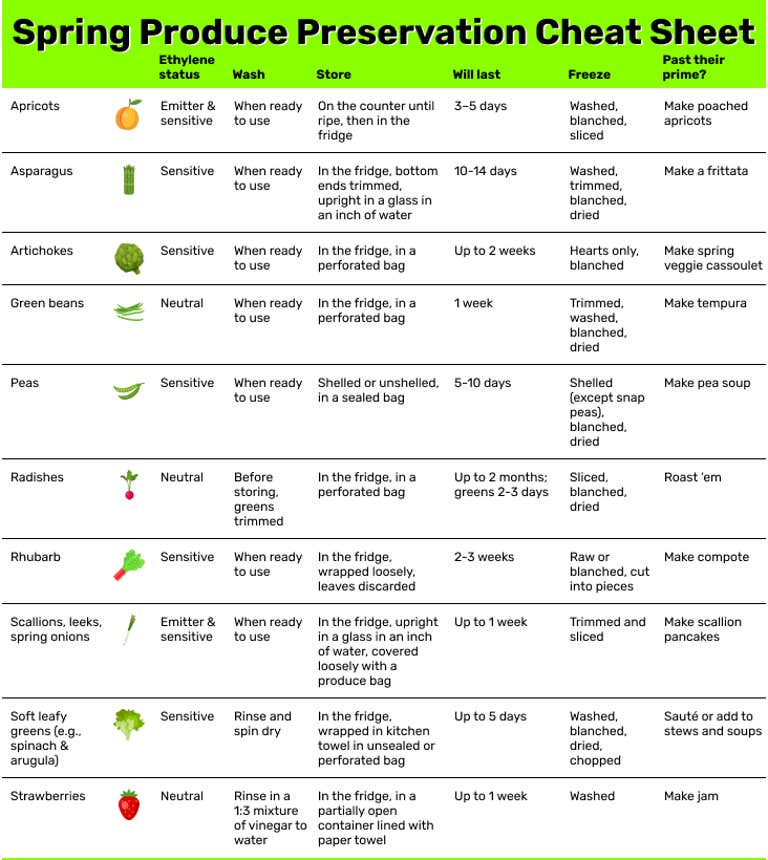This post has been updated. It originally published on Mar. 14, 2024.
The global food system creates a lot of waste. Food gets lost during harvest and shipping, grub spoils before it gets eaten, and leftovers languish in our refrigerators. But just because that’s the current state of our system, doesn’t mean we can’t all work towards lowering the amount of grub that ends up in the bin—and, ultimately, the landfill. Because of those rotting heaps, the environmental impact of food waste, in fact, is greater than that of 40 coal-fired power plants.
In the U.S., the majority of food waste happens in our homes, and cutting those losses takes a multi-pronged approach. In addition to smarter shopping and creative cooking, knowing how to store vittles properly can make sure more good food gets eaten. Here are a suite of tactics that address how we track, sort, package, and salvage vittles before they can become food waste.
Explore
Before you do anything: Understand expiration dates
Confusion over “expiration dates” is a leading cause of household food waste, according to ReFED.1 In reality, though, the dates stamped on food packaging are more an indicator of when the manufacturer thinks food is at its best, as opposed to a deadline about food safety. (Baby formula is an exception to this rule.) Check out our guide to what expiration dates actually mean, including a quick-glance guide to the lifespans of commonly tossed grub.
Organize your fridge to cut food waste
Sometimes lowering food waste means changing your habits when handling the food at your disposal—specifically storage and management. Here’s a range of tips to keep your fridge prepared for optimal snacking and minimal waste.
Create an ‘eat me first’ zone
Keep the most perishable items in sight towards the front of the fridge to ensure they aren’t forgotten. Make a designated place for any items that have spoiled quickly in the past. “This encourages everyone at home to prioritize consuming those items first, minimizing food waste,” says Stacy Savage, a zero waste specialist and the founder of consulting firm Zero Waste Strategies.
Try the ‘first in, first out’ rule
When you restock the fridge, think of it like a grocery-store shelf: The newest stuff goes in the back. This will help you keep track what’s in there and consume it in the order it arrived—more or less. If you keep a written inventory, you can also do this by writing down when an item went in. This way, you don’t get a surprise container of molded strawberries way in the back.
Seal leftovers tight
Make sure food-storage containers seal correctly so that any items will last longer. Some older containers and lids become warped over time, so it’s important to take stock of how well your food containers are holding up.
Let things breathe
Home and business refrigerators are often overpacked, Savage says, which can keep cold air from circulating correctly. If your fridge is starting to look like a subway car at rush hour, it’s a clear signal to inventory what you’ve got—and what rarely gets used.
Label everything
Label all your food containers–and don’t forget dates. “Use blue painters tape and Sharpie,” suggests Alison Mountford, a chef who runs the website and meal planning service Ends+Stems. “Often we toss out items when we can’t recall their age and that can be prevented with labeling.”
Organize your freezer to cut food waste
Think of a freezer like a food time machine. With proper packaging, labeling, and organizing techniques, it’s a vessel to extend the life of fresh food—and leftovers—that might go bad before you get a chance to eat them.
Label everything
We said it with the fridge, and we’ll say it again: Get a roll of masking tape and a Sharpie and record the contents and dates of everything you put in cold storage. This ensures that you’re not playing a guessing game with how long it has been since you had first stored those ingredients or that meal.
Wrap tightly
Air is a primary culprit for foods developing off-putting textures in the freezer, so however you package food, make sure to push out as much as possible. If you’re using freezer paper or foil, wrap it as tightly as you can; if you’re using freezer bags, push out any excess air before sealing.
Embrace the ice cube tray
Use ice cube trays to portion out usable amounts of half-stuff you have leftover. This is especially great for things like cookie dough, pancake batter, seasonings, broth, and extra bits and bobs ingredients for larger recipes—stuff like extra garlic, tomato paste, herbs, or chopped onions.
Separate by spoilage potential
Put things least likely to spoil on the door. This includes nuts, extra herbs, breads and baked goods, and butter. Out of sight and out of mind sadly creates more food waste.
Put meat on the bottom—just in case
The chance that you experience some sort of power outage, meat will spread a lot of bacteria and ruin whatever’s underneath it. So keep it at the bottom of the chiller so that germs and meat sludge doesn’t drip down on your other food.
Understand freezer burn
It might be unappealing, but freezer burn isn’t necessarily dangerous. Those ashy, discolored pieces happen because of inconsistent temperatures and too much air getting to grub. If only a small part of the food is affected, you can just slice it off.
Thaw safely
Freezing food puts any baddies that might make you sick on ice, and incorrect thawing can help them thrive. Don’t leave food on the counter to thaw; this could let it come between 40 and 140 degrees, which is what the USDA considers the danger zone. Thaw overnight in the fridge, or, if you’re in a rush, toss food in the microwave.
Store produce to avoid spoilage
Fresh fruits and vegetables are the most commonly tossed foods in U.S. homes, according to ReFED, a nonprofit focused on food waste solutions.2 Issue is: Extending the life of produce isn’t a one-size-fits-all scenario. Different grub requires different moisture levels and airflow to avoid spoilage and bacteria. A cucumber, for example, needs to hang out in the crisper drawer with a towel to wick away excess water, while a tomato prefers the airflow of a countertop. Knowing proper food storage tips for each type of product will help reduce waste.
A gaseous plant hormone called ethylene also impacts how quickly fruits ripen. Some produce emit more than others, so storing those heavy emitters nearer to grub that’s more sensitive to the gas can accidentally cause some fruits to spoil faster than they would otherwise. “Bananas emit ethylene and will cause all other fruits to ripen faster, so store them separately,” says meal planner Mountford. Apples and avocados fall into the same category as bananas, so they need their own storage as well. But when it comes to berries, grapes, and cherries, they don’t release ethylene as much post-harvest and can bunk with other fruits.
If this seems like a lot to keep track of, Savage of Zero-Waste Strategies has a simple suggestion: “Display informative posters in kitchens outlining proper storage practices.” We made a printable one here, but the quick season-by-season charts below can also help get you started:
Storage tips for spring produce
Many of spring’s delicious offerings—leeks, arugula, strawberries—are more delicate than their cold-weather counterparts. Moisture and microbes are harmful, but many seasonal fruits ripen quickly when exposed to ethylene gas. Asparagus, artichokes, peas, and soft leafy greens need to maintain their own quarters to maximize freshness.

| Ethylene status | Wash | Store | Will last | Freeze | Past their prime? | |
|---|---|---|---|---|---|---|
Apricots | Emitter & sensitive | When ready to use | On the counter until ripe, then in the fridge | 3–5 days | Washed, blanched, sliced | Make poached apricots |
Asparagus | Sensitive | When ready to use | In the fridge, bottom ends trimmed, upright in a glass in an inch of water | 10-14 days | Washed, trimmed, blanched, dried | Make a frittata |
Artichokes | Sensitive | When ready to use | In the fridge, in a perforated bag | 1 week | Hearts only, blanched | Make spring veggie cassoulet |
Green beans | Neutral | When ready to use | In the fridge, in a perforated bag | 1-2 weeks | Trimmed, washed, blanched, dried | Make tempura |
Peas | Sensitive | When ready to use | Shelled or unshelled, in a sealed bag | 5-10 days | Shelled (except snap peas), blanched, dried | Make pea soup |
Radishes | Neutral | Before storing, greens trimmed | In the fridge in a perforated bag | Up to 2 months; greens 2-3 days | Sliced, blanched, dried | Roast ‘em |
Rhubarb | Sensitive | When ready to use | In the fridge, wrapped loosely, leaves discarded | 2-3 weeks | Raw or blanched, cut into pieces | Make compote |
Scallions, leeks, spring onions | Emitter & sensitive | When ready to use | In the fridge, upright in a glass in an inch of water, covered loosely with a produce bag | Up to 1 week | Trimmed and sliced | Make scallion pancakes |
Soft leafy greens (e.g., spinach & arugula) | Sensitive | Rinse and spin dry | In the fridge, wrapped in kitchen towel in unsealed or perforated bag | Up to 5 days | Washed, blanched, dried, chopped | Sauté or add to stews and soups |
Strawberries | Neutral | Rinse in a 1:3 mixture of vinegar to water | In the fridge, in a partially open container lined with paper towel | Up to 1 week | Washed | Make jam |
Storage tips for summer produce
Summer’s produce bounty includes a range of fruits and veggies that require different types of care. Many stone fruits and tomatoes are ethylene emitters, for example, and need to be kept away from other soft fruits and veggies that go bad easily. Delicate herbs and summer greens like lettuce should be kept away from these emitting fruits and should be stored properly after being cleaned and patted dry.

| Ethylene status | Wash | Store | Will last | Freeze | Past their prime? | |
|---|---|---|---|---|---|---|
| Tomatoes | Emitter | When ready to eat | On the counter in an open container | 2 days to 2 weeks | Puréed | Blend into gazpacho; roast with garlic and oil |
| Berries | Neutral | Rinse in a 1:3 mix of vinegar and water, or submerge in hot water for 30 seconds | In the fridge in a partially opened container lined with paper towel | Up to a week for strawberries and raspberries; up to 2 weeks for blueberries | In a single layer and transfer to a container | Make preserves |
| Stone fruit | Emitter and sensitive | When ready to eat | On the counter until ripe, then in the fridge in a bowl | Up to a week | Sliced | Make compote |
| Cherries | Neutral | When ready to eat | In the fridge in a perforated bag or vented container | 1-2 weeks | Pitted | Make clafoutis |
| Cucumbers | Sensitive | When ready to eat | In the crisper drawer rolled in a towel | 1-2 weeks | Don’t | Blend into soup; make quick pickles |
| Squash & Eggplant | Sensitive | When ready to eat | In the fridge in a perforated bag or vented container | 1-2 weeks | Cooked | Make zucchini butter |
| Corn | Neutral | Don’t | On the cob, loose in the fridge | For best flavor, eat ASAP | Kernels only | Add to soup or bean salad |
| Lettuce | Sensitive | Rinse and spin dry | Rolled in a dish towel in a container or bag in the fridge | 1-2 weeks | Don’t | Grill or braise hearty varieties like romaine |
| Herbs | Sensitive | Rinse and spin or pat dry | Snip the ends, place upright in a glass with a little water in the fridge | 1-2 weeks | Rosemary, thyme | Make pesto |
Storage tips for fall and winter produce
A lot of fall and winter produce can emit ethylene and spoil the rest of your seasonal goodies. The ones to store separately are pears and potatoes. Keep those away from other sensitive fall and winter produce like celery and onions, which ensures that buying some seasonal produce in bulk won’t backfire on you.

| Ethylene status | Wash | Store | Will last | Freeze | Past their prime? | |
|---|---|---|---|---|---|---|
| Apples | Sensitive & emitter | Rinse when ready to eat | In the fridge, in an unsealed or perforated bag | Up to 3 months | Sliced, blanched, cooled in ice water, and dried | Make applesauce |
Broccoli & cauliflower | Sensitive | Rinse when ready to eat | In the fridge, in an unsealed or perforated bag | Up to 5 days | Cut into florets, blanched, cooled in ice water, and dried | Make creamy vegan broccoli soup or roasted cauliflower soup |
| Brussels sprouts & cabbage | Sensitive | Rinse when ready to eat | In the fridge, in an unsealed or perforated bag; uncut cabbage can be loose | Sprouts up to 10 days; cabbage up to 2 months | Sprouts trimmed, steamed for 3–5 minutes, cooled in ice water, and dried; cabbage cooked | Roast, or make melted cabbage |
| Celery | Sensitive | Rinse when ready to eat | In the fridge, wrapped tightly in aluminum foil | Up to 4 weeks | Washed, dried, and chopped | Braise it |
| Cranberries | Neutral | Rinse when ready to eat | In the fridge, in a sealed bag | Up to 2 months | Washed and dried | Make cranberry sauce |
| Dark leafy greens | Sensitive (they turn yellow) | Rinse when ready to eat | In the fridge, wrapped in a kitchen towel, in an unsealed or perforated bag | Up to 5 days | Washed, blanched, dried, and chopped | Sauté them |
| Grapes | Sensitive | Rinse when ready to eat | In the fridge, in an unsealed or perforated bag | Up to 2 weeks | Washed and dried, off the stem | Make grape compote |
| Onions | Sensitive | No | In a cool, dry place, separate from potatoes | Up to 6 weeks | Peeled and chopped | Salvage for parts |
| Pears | Sensitive & emitter | Rinse when ready to eat | On the counter until ripe, then in the fridge in an unsealed or perforated bag | 5–7 days | Don’t | Make a pear crisp |
| Potatoes & sweet potatoes | Sensitive, potatoes also emit | Scrub when ready to eat | In a cool, dry place, separate from onions | Up to 2 weeks | Potatoes peeled, parboiled 3–7 minutes, cooled, and cut; sweets cooked | Remove any eyes and mash potatoes; make sweet potato pie |
| Pumpkins & winter squash | Sensitive | Scrub when ready to eat | In a cool, dry place | Up to 3 months | Cooked | Make a gratin |
| Root veggies (carrots, parsnips, & turnips) | Sensitive (they get bitter) | Scrub when ready to eat | In the fridge, in an unsealed or perforated bag, green tops removed | Up to 1 month (shorter for baby carrots) | Peeled, blanched, and dried | Make carrot-ginger soup |
Store scraps to eliminate food waste
Kitchen scraps don’t all have to go straight to the trash. So many will make for great additions to other meals, recipes, or even as compost. Here are a few ideas:
Make a smoothie bag
Use extra or fast-spoiling produce as an opportunity to add more veggies and fruit to your drink. If you have greens or fruits (we’re looking at you bananas and berries) that are starting to go bad, gather them up in a freezer bag and toss them into the blender as needed.
Save end and stems for stock
So many ends, peels and stems of veggies can make for a great homemade vegetable stock. Gather all these up in a big freezer bag to form the basis of a flavorful homemade stock. Dump the scraps in a big pot, cover with water, add in some seasonings like peppercorns and a bay leaf, and let it simmer for a couple hours. Some experts recommend avoiding bitter greens like kale if you want a smoother tasting broth that will be great for making all sorts of stews and soups. For extra credit: You can char or bake the scraps in a little oil to deepen the umami-ness of the flavor.
Gather up compost
Depending on where you live, you can turn extra bits into compost in your own yard—or see if your city has a composting program. You can collect your inedible scraps in a dedicated compost bin. (Even a repurposed takeout container could work, but you may want to keep it in the fridge or freezer to avoid attracting pests.) To see if you have any composting programs near you, check out this website.
Bonus: Cooking and shopping tips to avoid food waste
Cutting down on the amount of food you throw out starts with how you plan out what your household is going to eat. That starts with a strategy for how you navigate the grocery store so that you don’t buy more than you need, and ends with some creative approaches to cooking to use up what you have on hand.
Additional reporting by Liza Schoenfein.
- Ibid ↩︎
- ReFed Insights Engine (2025), ReFED, (Accessed Sep. 2023) ↩︎

